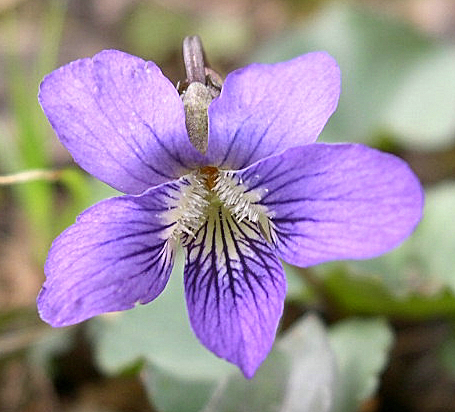Spring is finally showing itself here on Owl Acres. The cherry trees and the apple tree are in bloom. Catkins hang from other, less showy trees like the elms. We haven’t mowed yet, so the yard is loaded with little flowers. Yellow dandelions, purple henbit, and bluish-purple violets.
There are at least 600 species of violet in the genus viola, and the one most prevalent in my yard is the wild, or common blue violet. The common blue violet (Viola sororia) also goes by a plethora of other names including Confederate Violet, Dooryard Violet, Florida Violet, Hooded Blue Violet, Meadow Violet, Missouri Violet, Purple Violet, Sister Violet, Wild Violet, Wood Violet, and Woolly Blue Violet. This violet has carried several scientific names in its history as well. With so many names, you can imagine that this little native plant is found everywhere in Eastern North America. It will grow in shade or sun, on dry, wet or damp ground. It is a perennial, so a plant can live up to ten years. They tend to grow in clumps because one way they propagate is by sending out above-ground runners that root at nodes along the stem to form baby plants. This allows the parent plant to spread in all directions.
Common blue violets bloom in early spring, sending up five-petaled purple flowers with white throats. The flowers droop over on the stems, pointing at the ground. The three lower petals tend to be hairy or bearded. These flowers are pretty, but they don’t produce seeds. They do produce nectar to attract pollinators. Three types of bees have specialized in violets, and a couple butterflies pollinate them as well. The seeds are produced later in the summer. A type of blossom forms but does not open. It self-pollinates within the plant and forms a seed capsule where the seeds develop. When it’s time, the seed capsule turns upright, opens, and shoots out the seeds up to nine feet away. To assure a wide distribution of its seeds, the violets coat them with a substance that some types of ants like to eat. The ants take the seeds to their nests and eat the coating. Then they throw the seeds away in their trash pile, which happens to make a perfect bed for the seed to germinate and grow.
Violets, like other “weeds” in the yard, are good for what ails you according to herbalists old and new. An 1828 guide noted that Americans were using its leaves and flowers as remedies for headache, sore throats and constipation. The leaves are high in vitamins A and C and can be added to salads. Some people even make candy out of the flowers.
It’s time to mow—the yard has gone crazy. The violets are perennials, so they’ll be back next spring.
Photo by Jay Sturner

2 comments
I’m enjoying your posts Karen. We have violets in our yard also. We added them to salad in the past. They taste fine and are a pretty addition. Joe finally just mowed this past Friday. We decided to try the “mow less in May” approach as opposed to the “no mow May”. We didn’t want the yard to get away from us or irritate the neighbors.
We had to do the “mow less May” too. The yard went crazy, and “first cutting” was more hay than clippings.